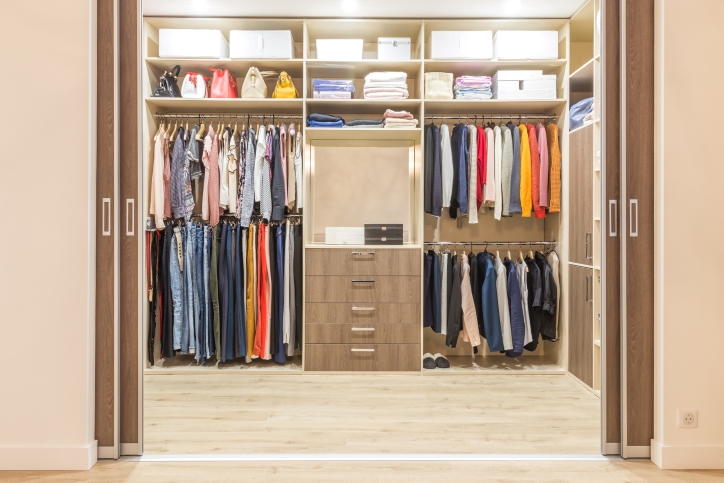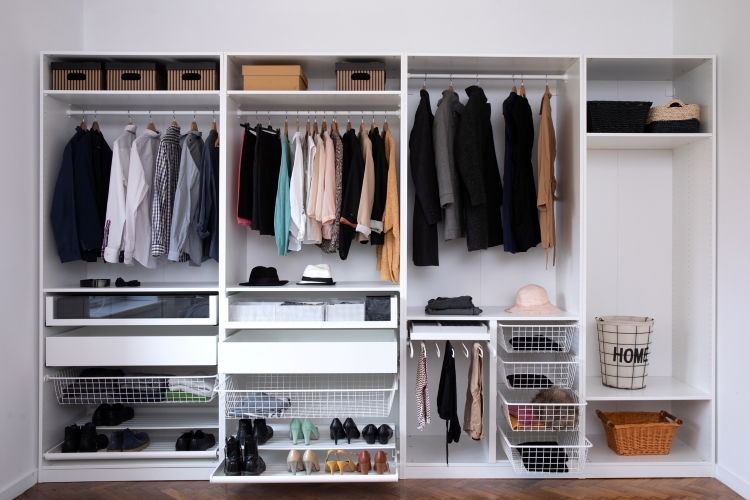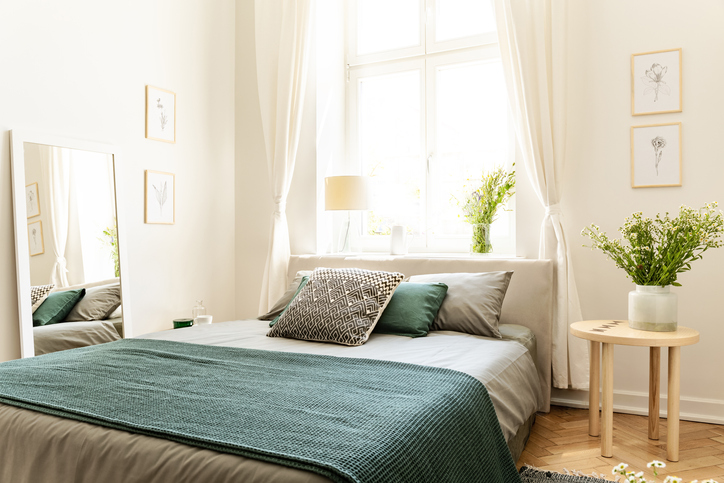Learning how to organize a closet has gone from a boring, household chore to a hot, potentially life-changing trend over the past few years. Personal organization expert Marie Kondo and her extreme pruning process have become a pop culture phenomenon in home design. Fashion-forward bloggers and clothing stores have focused on creating carefully curated capsule wardrobes that pare down closets to mostly the essentials and streamline the process of getting dressed—there are so many closet organizer ideas out there.
DIY Closet Organizer Ideas on a Budget
But, even with the slew of ideas out in the wild, many of these trends assume an unlimited budget and plenty of time to devote to pondering the merits of every scarf and pair of socks. Can you learn how to declutter your closet and create a functional wardrobe, using the clothes we already own, in just one weekend? It’s totally doable. Here are 10 steps that will quickly turn your cluttered, confused closet into an organized collection of wearable pieces—and increase your wardrobe confidence.
1
5 Initial Closet Organizer Ideas and How to Declutter Your Closet
There are so many great DIY closet organizer ideas on a budget out there that can open both closet and area space in your home. Are you ready to experience more wall space, hanging space, closet space and to ultimately, feel good? Let’s get to it.
How to Organize a Closet Step 1: Prepare to Declutter
Before you start organizing your closet, prepare to declutter by grabbing three boxes, bins, or trash bags, plus a pen and paper or some other way to take notes. You’ll also want to have at least two or three hours (or longer if you haven’t sorted through your wardrobe in years) blocked on your schedule and a private area where you can try on clothes. Are you ready to declutter your closet and start space-saving?
How to Organize a Closet Step 2: Collect Your Wardrobe
Take all your clothes out of your closet, as well as your dresser and anywhere else you store clothing. Even if your main goal is cleaning up a messy bedroom closet, or you are looking for small closet organization ideas, it’s important to evaluate your wardrobe, or the things in the closet as a whole, including items you store elsewhere—be they plain t-shirts or things you rarely wear.
Taking a good look at how every piece functions together—or doesn’t—will help you not only organize your closet and other clothes storage areas but keep them organized for good. Place everything in a big pile on a bed or the floor. If possible, do this near a full-length mirror so you can try on outfits to see how they look. This is an important step to learn how to organize a closet.
How to Organize a Closet Step 3: Ditch the Obvious “No” Clothes
Designate one box, bin, or bag for clothes to throw away. This should include anything that’s permanently stained, ripped beyond repair, or so worn or outdated that no one else would want it. Use another box, bin, or bag for clothes to donate, sell or maybe even add them to your yard sale. These will be items that don’t fit your body or current lifestyle, items you no longer like, anything that’s uncomfortable to wear, and so on, free up some of that hanging space!
Go through every item of clothing you own—you don’t have to try anything on yet—and put any piece that’s clearly ready to be discarded or passed on into the proper box. Don’t worry about items you’re unsure about. Just set aside the clothes you’re never going to wear again.
How to Organize a Closet Step 4: Save the Obvious “Yes” Clothes
By this step, your pile of clothes has probably shrunk. Now carefully go through what remains. If you haven’t worn something in a long time, try it on. Be honest about items you love, what looks good on you, and what actually works with your current lifestyle. During this process, you will probably find more items for your discard and give away/sell boxes.
You should now have two categories of clothes: definite keepers that you love, flatter you and are practical for your life, and pieces you’re unsure of, which might fit one or two of those three criteria but aren’t perfect enough for you to be completely sure about them. If you need small closet organization ideas, err on the side of getting rid of what you are unsure of because you have less space to keep anything but what you love or is necessary.
How to Organize a Closet Step 5: Pack Your “Unsure” Box
Pack all those “unsure” items into the third box. You will have more chances to decide on these, so err on the side of reducing your wardrobe to all items that are a yes and put the clothes you doubt even a little into the “unsure” box. Store this box in a closet, basement, or another safe but out-of-sight location for three months. If you want to wear something from the box, you can always add it back to your wardrobe. Or, discard or donate it if you find it doesn’t work.
After three months, reevaluate what’s left in this box. If you’re still not sure what to get rid of and what to keep, store them for another three months. You can always add them back into your wardrobe, and you have the option to transfer items from your closet to this box. If you don’t miss an item for a year, you can probably let it go without regret.
2
5 More Simple Closet Organizer Ideas to Help Streamline Your Life
How to Organize a Closet Step 6: Separate Your Clothes by Season
Now that your wardrobe consists of “yes” clothes only, separate these by season. If summer is coming, stash your fall and winter clothes in a storage area in your home, or put them to the side or back of your closet. If you live in an area without four distinct seasons, skip this step or divide your “yes” clothes into those you want to wear for the next few months and those you don’t.
The point of storing off-season clothes is to make dressing as easy as possible. When you open your closet door in the morning, you want a choice of outfits you can really wear that day—not distractions, like shelves full of heavy sweaters in July and August.
How to Organize a Closet Step 7: Create Potential Outfits
You should be left with a collection of clothing that fits, works realistically with your lifestyle, is wearable in your current season, and pleases you. Look at the items together to figure out which items work together and form an idea of how many whole outfits you have. Try them on to make sure, because although blue jeans and a red shirt go together in theory, the cuts of your particular pieces might look wrong together, meaning that you have fewer real-life outfits than you thought.
How to Organize a Closet Step 8: Evaluate Gaps in Your Wardrobe
As you create outfits, you might notice a hole or imbalance in your wardrobe. Maybe you have lots of great work options, but few casual clothes. Maybe you have a range of tops but few bottoms to pair with them. Maybe an old, favorite summer dress ended up in the “donate/sell” box, and you have no replacement. Or maybe you have everything you need.
Don’t look for reasons to buy clothes—just ask yourself whether your wardrobe, as it is now, will see you through the next season or year. Consider what you do on a regular basis: If you had to dress for a meeting, lunch with friends, a date night, a walk on the beach, what would you wear? Are you happy with your outfit options?
How to Organize a Closet Step 9: Make a Shopping List
If your wardrobe isn’t quite complete, figure out what clothing items would fill the gap. Make a list, and be specific—a lightweight, white crew neck sweater, say, or a knee-length, black jersey dress, or a pair of straight-leg jeans. Keep this list on your phone or in your car, so that if you end up at a clothing store, you can refer to it and avoid the temptation of pretty things that won’t fit with the rest of your newly pared-down wardrobe. Shut your closet door with confidence!
How to Organize a Closet, The Final Step: Optimize Your Closet
One of the tops tips to consider when you declutter a closet is to organize everything in a way that makes getting dressed easier and faster. Group like items together—shirts with shirts, skirts with skirts. Within each group, arrange clothes by color, style, and/or weight, such as short-sleeve blouses from light to dark, then long-sleeve blouses from light to dark, then heavy shirts from light to dark, and so on.
Point all hangers in the same direction and stack folded items neatly. You might want to keep all your dressy clothes together, especially if you don’t wear them on a regular basis. The goal is to be able to see everything you have and choose which items you want to wear, without having to rummage through a tangled mess.

Once you’ve completed your initial wardrobe overhaul, you can maintain your newly organized closet by repeating the process on a much smaller scale each season. When the weather changes, just bring out your stored off-season clothes and brainstorm outfit combinations, shop if necessary, and hang everything up neatly. If your climate doesn’t require a seasonal wardrobe shift, you might want to reevaluate your clothes once or twice a year, or even every few years.
Over time, the act of tweaking your wardrobe and keeping your clothes organized will become second nature, and you’ll forget you ever saw your closet as a source of stress.
Do you have any additional closet organizer ideas you take to clean out your closet? Let us know in the comments below!







None at this time.
Thank You!
Very good and helpful article.
Thank you, Hartford, for continuing to provide unique, time-saving ideas for making life more manageable. This added support is why I’ve remained a Hartford Homeowners, Automobile, and Umbrella insurance customer for over 20 years!
Cheers,
Frank F Kling
That’s so great to hear, Frank! Thank you for being a customer and thanks for reading Extra Mile!
I color code my hangers with the main colors of my clothing items. That way I can just look for the color of the hanger to find clothing to match. I also keep all the same colors together.
Ask yourself if you have worn it in the last 2 years. If not, get rid of it.
I feel completely overwhelmed by starting this project which I have not tackled in over 10 years. I’m addition to my flooding closet, I have clothes I wear more regularly hanging from my 4 poster bed.
I have considered speaking with a small independent store owner I am friendly with to see if I could pay her to come help. Not sure what to pay her. Would also like to take some things to thrift shops and share the money from it with her.
If I had a closet like the one in the photo, clutter wouldn’t be a problem. I’m dealing with a closet so narrow I have trouble reaching the overhead shelf where there are clothes hanging below it.
Place a battery charged light in your closet that turns on only when it senses movement.
This illuminates dark closets; shows true color of items, making selection easier for around a cost of $12. A big help to seniors.
For Sunny,
I’d say your second assumption is right.
How come “closet organizers” never make these recommendations directed at men?
Because men have a third of the clothes and are generally better organized. Their mommies made them do that long ago. 🙂
I do have a few comments and the ones already given are great.
It’s nice to put some type of freshener in the closet. Nothing over-powering or you’ll be up all night with
the smell! Even if you put an open box of baking soda on a corner of the floor.
Also, shoes can sometimes not smell very fresh. (I put mine and handbags in the washer – no, they don’t fall apart). I do not think that putting shoes in any closed container is a good idea – yucky, Instead, my shoes are on racks at bottom of closet and I place a scented plastic bag over them.
I have one special tote bag for swim wear: bathing suits, water sandals, cover-up, sun tan lotion, small container for toiletries, beach towel, roll-up sun hat, etc. When summer or beach vacation time comes I just put that swim bag in the car and I’m ready to roll !
Regarding themed t/shirts — I keep them separate from others so it’s easy to find that special one (Halloween, cancer, Xmas etc.
I kinda love how this assumes that either men don’t have messy closets or that they just don’t care : )
I have another category to add. I also separate my clothes by activities. Christmas shirts, shoes, sweaters etc. Halloween shirts, costumes etc. Easter, Valentine, Thanksgiving, 4th of July, and keep them in the small closet. When my friends and I have special occasions – Wine glass on shirt, Flamingo shirt, flip flops, or sun glasses on beach clothes , pocket book all are special occasions. Funeral clothes, church clothes, etc. On my special occasion clothes ALL accessories are with it.
Great idea, Mable!
My shoes are hung on the back of my door on a special open rack keeping everything thing neat and handy. I keep out of season clothes in vacuum bags which remove air and allow safe flat storage.
I would add one step – when the closet and drawers are empty clean them! Vacuum into the corners. The back of the closet and shelves never get clean and accumulate a lot of dust and hairballs.
Good tip to include!
In addition to separating spring/summer vs fall/winter, put in color order. White to Black. It’s very helpful when making that daily decision of what to wear!
I also put outfits together and photograph on my IPhone so I can add accessories to the outfits while shopping. Plus when planning a vacation, easy to thumb thru outfits to take.
This is a great idea Marilyn, thanks for sharing!
Great suggestions, I followed them.
Gave three bags of clothes to SA.
Put winter clothes away, color coded my blouses, skirts and slacks.
Stacked my Jean’s, T shirts, shells. Hong my scarfs behind my door on a rack.
Feels so good.
What about shoes and hand bags
Hi Yasmin, you can find more about organizing these items in our article here.